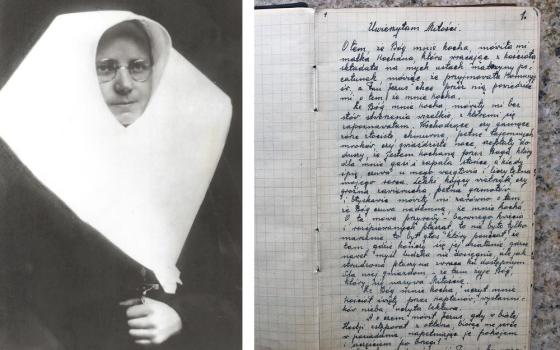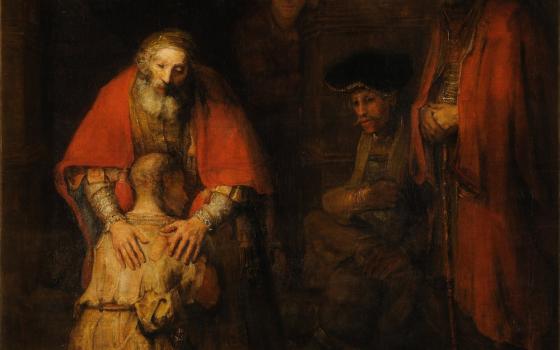
The film 'Camino' follows six pilgrims hike from southern France to Santiago de Compostela, Spain. (CNS/courtesy CaminoDocumentary.org)
When director Emilio Estevez’ feature narrative film “The Way” was released in 2011, audiences across the United States and many countries were introduced for the first time to the ancient pilgrimage route “El Camino de Santiago de Compostela.”
I had the opportunity to interview Martin Sheen at that time for NCR and followed it up with an article about a screening in which Sheen, his son Emilio Estevez, and producer David Alexanian, spoke to the audience after. “The Way” is a fictional story about an American eye doctor who takes his deceased son’s place on the Camino and is transformed.
At this writing, a documentary about the Camino is being released: “Walking the Camino: Six Ways to Santiago.” It was in production at the same time as “The Way” but the filmmakers, led by director/producer Lydia B. Smith, ran out of funds to finish it. Sheen, who saw an early cut of the film, called it “brilliant” and “wonderful.” Sheen is known for his generosity and kindness so his comments may seem effusive. However, this documentary is very fine indeed.
“Walking the Camino” follows six key pilgrims: Samantha Gilbert (Brazil/UK), Tomas Moreno (Portugal), Anne-Marie “Misa” Misser (Denmark), Wayne Emde (Canada), Tatiana Jacquot (France) and Annie O’Neil (USA and a co-producer of the film). Of course there are others who come in and out, hostellers who comment as well as a bishop and a Franciscan priest.
As in “The Way,” this film starts at St. Jean Pied de Port, the beginning of the most famous of all the pilgrim routes to Santiago, the Camino Francese. As one priest says at the beginning of the film, people make the pilgrimage for many reasons: devotion, purification, and penance being the more traditional motives. In the olden days, going back 1,200 years, people used to walk the Camino instead of going to jail, and even then some people would pay others to walk it for them, which rather defeats the purpose. One thing is for sure, walking the Camino will change your life.
Single mom Tatiana is walking the Camino with her 3 year-old son Cyrian in a stroller and her brother Alexis. Tatiana is a believer while her brother is not and they are an unlikely pair because they don’t usually get along. They make it together almost the whole way before Alexis’ party behavior and language divides them. But at the end Tatiana admits that she started the Camino wanting to change Alexis but she is the one who changed.
Samantha lost her job and is depressed. But she discards just about everything, even the pills, before starting the Camino. She cut her hair and dyed it another color. And for a whole month she goes without shampooing her hair. By the end she has found interior meaning and a resolve to really live. She admits that people told her she would find answers on the Camino but realized that she didn’t even have the questions. The more she walks, the more her depressions lifts.
Wayne is a widower who is walking with Jack who had presided over his wife’s funeral four years before. Early on he reflects that “there may be something beyond this, but today I have this, the Camino, and I will walk this day the best that I can.” Jack is more spiritual than Wayne and says, “If you go to Santiago searching for him you will not find him … unless you take him with you from the beginning.” Later Wayne says, “Every day is a journey and the road itself is home.”
Annie is a wide-eyed American and walking the Camino is very hard for her. Besides enduring the physical pain, she doesn't want to sleep mattress-to-mattress with a stranger but she does it anyway. The next day the German man who slept next to her sees how she is struggling with her backpack and carries it for her. Annie is moved and says, “I have never been that kind to anyone in my life.”
Tomas is a young man from Portugal who “parachuted” in to walk the Camino, meaning he did it without much reflection or preparation. The film opens with him popping the blisters on his feet.
Misa is from Denmark and it’s only she and her mother at home. She walks very fast. Misa meets William from Canada and though he is about 10 years younger, they have a lot in common and spend every moment together until they get to the coastal town of Finesterre beyond Santiago, once thought to be the end of the world. They are the only pilgrims who seem to begin a relationship. Perhaps they will have a future. But it is Samantha who comments that “No woman would try to find a husband on the Camino … between the snoring, farting and smelly boots …”
“Walking the Camino” is beautifully shot and we get to see inside the hostels, refugios or alburgues. We meet some of the volunteers at the monasteries who welcome and feed the pilgrims. At one monastery the volunteers wash the feet of the pilgrims. At another, they are invited to spend time in silence, to reflect on their experience. Throughout, the scenes of the churches are warm and landscapes are stunning.
The film briefly introduces Martha, a South Korean woman who is making the Camino alone. She has been married 27 years. She says that throughout her married life her husband always said, “I love you” and she could only respond, “Me, too.” Then one night on the Camino she called him and told him, “I love you” for the first time. “Walking the Camino makes me brave; I can do anything,” she says.
There is one scene when some of the pilgrims talk about — and imitate — the inevitable snoring. It’s pretty funny because as one young man says, “Someone is always snoring.”
As the pilgrims go along some send home what is extra or leave things behind. They find that they can live on very little. Wayne says, “It is a simple existence, addictive. All you own is in your bag … and then you walk.” Another says, “The only baggage you carry are your fears.”
“Walking the Camino” makes me wish I could walk it today. It could be a promotional film for the Camino but I think it works even for people who are unable to make that 500-mile pilgrimage because we are all on a journey, we are never “finished.” The film lets you see that it is no “walk in the park.” It can rain frequently and the mud can be thick — if it is mud, because it could be cow dung, too.
But there’s a freedom to walking the Camino. Just as Tom, played by Sheen in “The Way,” comes to see life and faith differently by the end of his Camino, we see it in the pilgrims in “Walking the Camino.” I think these two films, one fictional and one a documentary, complement the other beautifully. In fact, the documentary lets us see more details of what the pilgrimage entails than does “The Way” such as what the hostels and facilities look like and how much more Christian imagery is to be found along the way. Both films conclude at the Basilica of Santiago but the documentary is less dramatic than “The Way” except for Tatiana for whom it is a deeply religious experience.
The Camino is a Christian activity but it is open to people of all nationalities, cultures, and religions. There the pilgrims will encounter new people, culture and food, and it will change them.
As the Franciscan priest says, “The Camino is pure medicine. It heals many hurts of the heart and the soul. Contact with nature does much good. When we are in harmony with nature and others, we feel better.”



